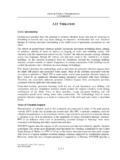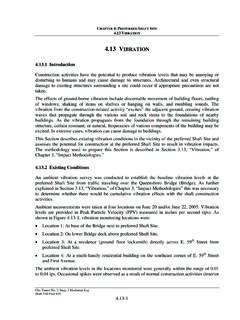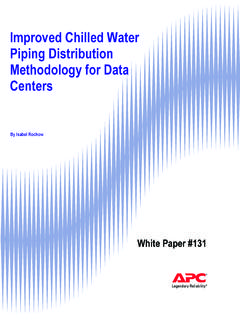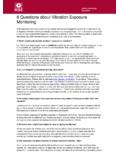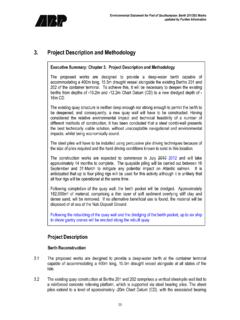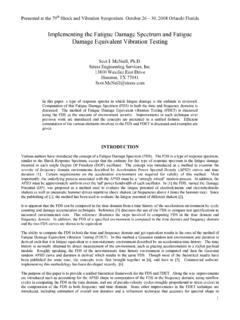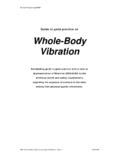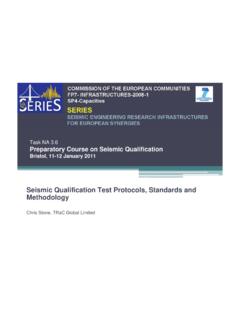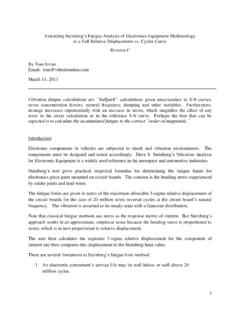Transcription of White Paper: PeakVue Analysis for Antifriction Bearing ...
1 Machinery HealthWhite PaperDecember Analysis for Antifriction Bearing Fault DetectionPeak values ( PeakVue ) are observed over sequential discrete time intervals, captured, and analyzed. The analyses are the (a) peak values (measured in g s), (b) spectra computed from the peak value time waveform, and (c) the autocorrelation coefficient computed from the peak value time studies of various classes of faults are presented to illustrate the PeakVue methodology . The classes of faults are (a) inner race defects, (b) outer race defects, (c) rolling element defects, and (d) cage related defects. All three Analysis tools enable the identification of the defect and often the severity of the PaperDecember HealthIntroductionThe peak value Analysis ( PeakVue ) methodology introduced by Emerson for the Analysis of impact-like events is proven to be an effective tool for identifying Bearing of Signal Processing for Vibration AnalysisThe analog signal from the vibration sensor is generally routed through some analog signal processing, converted into a digital format and then further processed digitally.
2 The vibration sensor often is an accelerometer whose output is expressed in g units. The signal processing may include conversion of the signal from acceleration to velocity units employing an analog integrator. The analog signal (g or velocity units) generally is passed through a high order low pass filter immediately before the analog-to-digital converter to remove any signal components which may be present at frequencies greater than the Nyquist frequency defined as one half of the sampling provides assurance that the digital representation of the analog signal is correct, , the band limited analog signal existing prior to digital conversion could be reconstructed from the digital a block of digital data is acquired at a constant sampling rate of desired length, typically a block size of 2n where n is an integer, the digital data are further processed. By far the most common processing for analyzing rotating equipment is the Fourier Transform, using a FFT algorithm to construct the spectrum either in acceleration or velocity units.
3 The spectral Analysis is helpful in separating the band-limited signal into periodic components related to the turning speed of the addition to spectral Analysis , auto-correlation Analysis can be applied to the digital block of data representing the time waveform. These additional correlation analyses have not proven to be helpful to the normal spectral Analysis , but it can be beneficial for Analysis of time waveform acquired when employing PeakVue PeakVue Analysis , no low pass filter at or slightly below the Nyquist frequency is employed. Instead, a high pass (or band pass) filter greater than or equal to the nyquist frequency is employed. The digital block of data consists of absolute maximum values, which the time waveform experiences over each time increment defined by the sampling rate. Hence the Analysis of this representative time waveform is the Analysis of peak Analysis of this block of data consists of the peak values themselves and an identification of periodicity that is best accomplished using spectral Analysis .
4 The autocorrelation Analysis has also been found to be very beneficial for the peak value time StudiesThese case studies demonstrate the signature accompanying various Antifriction Bearing faults for a wide variation in machine speed. The PeakVue time waveform will also be emphasized relative to trendability and fault severity assessment. The primary emphasis will be placed on the peak values in the PeakVue time waveform, the spectral peaks and presence or absence of sidebanding, and the periodic activity in the autocorrelation coefficient case studies presented are: Outer Race Defects zPinion Stand Gearbox zCrowd Motor Inner Race Defects zCrusher gearbox zPrecision13 drill head spindle3 White PaperDecember Health Ball or Roller Defect zChipper zRougher gearbox Cage and others zLubrication zSingle stage rotary air compressorOuter Race DefectsThe first case study is from a pinion stand gearbox at a steel producing facility.
5 The normal spectral data taken for a 1000 Hz bandwidth had g levels of 2 g s and no indication of a Bearing problem. The input shaft speed was about 360 PeakVue spectra and time waveform data are presented in Fig. 1. A high pass filter of 1000 Hz was used. Significant activity at the outer race defect frequency with many harmonics is present. The impact levels are as high as 37 g many harmonics are present in the spectral data, it is obvious from the PeakVue time waveform that the time between impacts corresponds to the outer race fault frequency (the harmonics are of no physical significance). This is also demonstrated in the autocorrelation coefficient function presented in Fig. 1: PeakVue Spectra and time waveform from input shaft of pinion stand gearbox4 White PaperDecember HealthFigure 2: Autocorrelation coefficient from PeakVue time waveform in Fig 1 Figure 3: Photograph of defective Bearing from the inlet of pinion stand gearboxThe impacting levels trended from 18 g s in July to a high of 37 g s in September.
6 The levels had decreased to 14 g s in October prior to a Bearing PaperDecember HealthThe second case study is from a centrifugal service water pump rated at 12000 gpm driven by an 8 pole 700 hp motor. Normal route-based vibration monitoring identified an outer race defect of reasonably low level (the peak-to-peak g level was g s). The fault was identified as alert and hence was to be trended. On December 8, 1997, PeakVue was employed and showed both outer and inner race defects with a signal level of 10 g s. A second PeakVue reading was taken on December 22, 1997 and is presented in Fig. 4. The impacting levels had increased to 33 g s. The pump was then placed on the fault level and the Bearing was replaced. The autocorrelation coefficient computed from the PeakVue time waveform is presented in Fig 5. The autocorrelation coefficient data shows the only activity of significance is the impacting from the outer race 4: PeakVue spectra and time waveform from outboard on service water pumpFigure 5: Autocorrelation coefficient from PeakVue waveform in Figure PaperDecember HealthFigure 6: Photograph of defective service water pump Bearing , showing inner and outer race this case, normal vibration data did identify the fault; however, the low levels observed did not place the fault at a level of significant concern.
7 The impacting levels identified in PeakVue , excess of 30 g s, raised the concern level and initiated planning for Race DefectsThe first inner race defect case involves a crusher gear box. The input shaft of this gear box has three bearings. The output of the gear box turns a crusher used at a mining site. The gear box, approximately 8 ft. 10 ft 20 ft, is powered by an eight pole 2000 hp trend observed on this Bearing using PeakVue was:February 13, 1997: Cage defect dominant but no other Bearing fault. Peak impacting g 28, 1997: Inner race dominant with peak impacting of g 20, 1997: Cage and inner race defeat with peak impacting of g 27, 1997: Cage and inner race defeat with peak impacting of g PeakVue data acquired March 20, 1997 are presented in Fig. 7. The cage activity at Hz ( orders) is identified. The inner race defect ( Hz) at orders is being sidebanded by running speed.
8 The inner race defect was not detected in the normal spectral PaperDecember HealthFigure 7. PeakVue spectra and time waveform from inlet of crusher gear 8. Autocorrelation coefficient from PeakVue time waveform of Figure autocorrelation coefficient function computed form the PeakVue time waveform in Fig. 7 is presented in Fig. 8. The inner race defect is clearly evident with amplitude modulation at running speed. The peak g levels for an inner race are generally not as large as for those accompanying an outer race defect. This is expected since the stress waves accompanying an inner race defect will experience attenuation in reaching the outer peripherals (where the sensor is attached) of the Bearing was replaced in June, 1997. The inner race had deep spalling over an approximate 1 PaperDecember HealthThe second case study deals with a precision 13 drill head spindle.
9 Bearing defect, especially inner race defects, detection on these precision multi-drill head spindles have proven to be difficult to impossible using normal velocity spectral Analysis . PeakVue methodology was applied to several of these multi-drill head spindles and demonstrated to be an effective tool for Bearing defect detection. On the class of spindle monitored, the high-frequency accelerometer was magnetically attached to the base of the spindle and data acquired in the unloaded position. An alert level was set at g s on the PeakVue time waveform. When this level was exceeded, an alert is set signifying a problem is present. PeakVue spectral Analysis was then employed to identify the 9. PeakVue spectra and time waveform from a spindle on a 13 multi-drill head 10. Autocorrelation coefficient from PeakVue time waveform acquired on the spindle of Figure PaperDecember HealthThe PeakVue spectra and time waveform for a spindle with a confirmed inner race defect are presented in Fig.
10 9. The inner race defect at ( orders) Hz is identified with side banding (twice running speed is dominant). The autocorrelation coefficient function computed form the PeakVue time waveform is presented in Fig. 10. The dominant activity here is at the inner race defect frequency. The Bearing was replaced. The Bearing had deep spalling on the inner or Roller DefectFollowing a shutdown where work was done on this chipper machine, the acceleration time waveform for a 500 Hz bandwidth spectra indicated some impacting may be occurring, see Fig. 11. The p-p g levels were less than 1 g which are not judged to be significant. The velocity spectra had a low 1x component but there were no obvious Bearing 11. Velocity spectra and acceleration time wave form from inboard axial on a PaperDecember HealthFigure 12. PeakVue Spectra and time waveform from inboard axial on 13.










